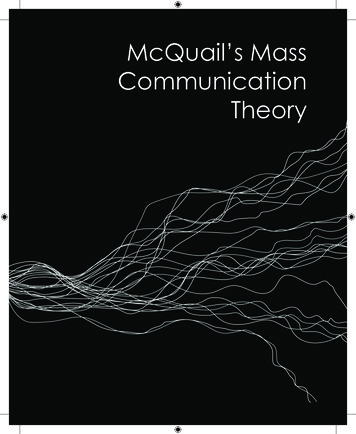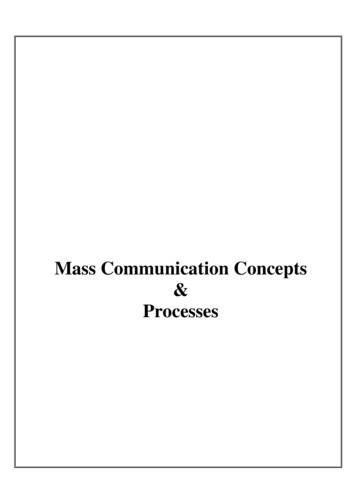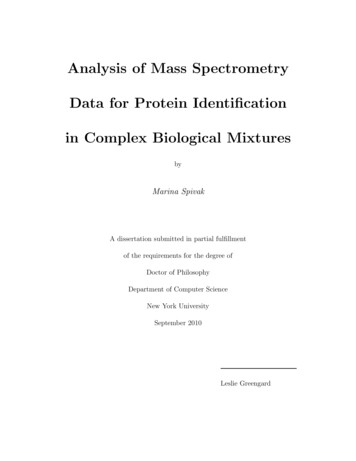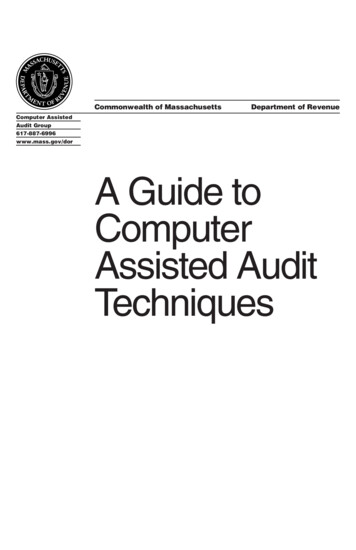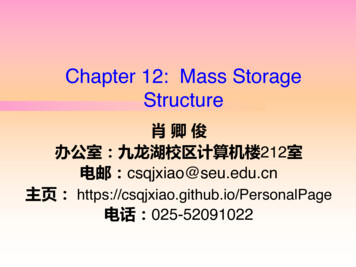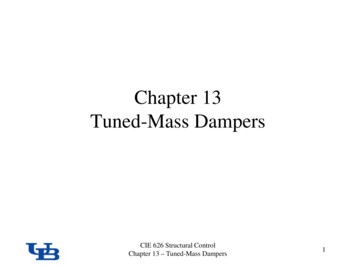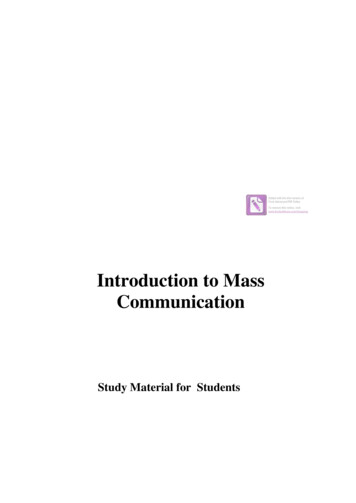
Transcription
Edited with the trial version ofFoxit Advanced PDF EditorTo remove this notice, visit:www.foxitsoftware.com/shoppingIntroduction to MassCommunicationStudy Material for Students
Edited with the trial version ofFoxit Advanced PDF EditorTo remove this notice, visit:www.foxitsoftware.com/shoppingIntroduction to Mass CommunicationCAREER OPPORTUNITIES IN MEDIA WORLDMass communication is institutionalized and source specific. It functionsthrough well-organized professionals and has an ever increasing interlace.Mass media has a global availability and it has converted the whole worldin to a global village. A qualified professional can take up a job ofeducating, entertaining, informing, persuading, interpreting, and guiding.Working in print media offers the opportunities to be a news reporter,news presenter, an editor, a feature writer, a photojournalist, etc.Electronic media offers great opportunities of being a news reporter, newseditor, newsreader, programme host, interviewer, cameraman, producer,director, etc.Other titles of Mass Communication professionals are script writer,production assistant, technical director, floor manager, lighting director,scenic director, coordinator, creative director, advertiser, media planner,media consultant, public relation officer, counselor, front office executive,event manager and others.2 Y
Edited with the trial version ofFoxit Advanced PDF EditorTo remove this notice, visit:www.foxitsoftware.com/shopping: Introduction to Mass CommunicationINTRODUCTIONMass communication is the term used to describe the academic study of variousmeans by which individuals and entities relay information to large segments of thepopulation all at once through mass media.This book comprise of four units. First unit of this book explains the meaning andsignificance of mass communication. The unit will explain the importance masscommunication and differentiate between various types of mass media. Thevarious features and techniques of mass communication are also discussed in thisunit.Second unit of the book discuss the various models of mass communicationsthrough diagrammatic representation and also explains each model’s structure andimportance.Third unit is the theories of mass communication. This unit helps you to know eachtheory and understand the relation between mass communication and society.Fourth unit explains the difference between communication and MassCommunication in detail.3
Edited with the trial version ofFoxit Advanced PDF EditorTo remove this notice, visit:www.foxitsoftware.com/shopping: Introduction to Mass CommunicationINDEX102 Introductions to Mass Communication1-INTRODUCTION TO MASS COMMUNICATION1.11.21.31.41.51.61.71.8Mass CommunicationMeaning of Mass CommunicationElements of Mass CommunicationDifferent Media of Mass CommunicationNeed & Importance Of Mass CommunicationSummaryExercises And QuestionsFurther Reading2-MODELS OF MASS ctionModels of Mass Communication2.2.1 Lazarfield Two Step flow2.2.2 Dependency model2.2.3 Agenda Setting & Effect Model2.2.4 Model of Gate KeepingSummaryExercises and QuestionsFurther Reading3- THEORIES OF MASS COMMUNICATION3.13.26-27IntroductionTheories of Mass Communication3.2.1 Authoritarian theory3.2.2 Libertarian theory3.2.3 Social Responsibility3.2.4 Soviet Media3.2.5 Development Communication3.2.6 Democratization TheorySummaryExercises and QuestionsFurther Reading44-50
Edited with the trial version ofFoxit Advanced PDF EditorTo remove this notice, visit:www.foxitsoftware.com/shopping: Introduction to Mass Communication4 - COMMUNICATION V/S MASS ng & Importance of Communication and MassCommunicationFunctions of Communication and Mass CommunicationElements & KindsSummaryCommunication V/S Mass CommunicationSummaryExercises and QuestionsFurther Reading
Edited with the trial version ofFoxit Advanced PDF EditorTo remove this notice, visit:www.foxitsoftware.com/shoppingIntroduction to Mass CommunicationSYLLABUSUNIT 1-INTRODUCTION TO MASS COMMUNICATIONMass Communication, Meaning, Need, Types, Elements of Mass Communication.UNIT 2-MODELS OF MASS COMMUNICATIONLazarfield Two Step flow, Dependency model, Agenda Setting & Effect Model,Model of Gate KeepingUNIT 3- THEORIES OF MASS COMMUNICATIONAuthoritarian, Libertarian, Social Responsibility, Soviet Media, DevelopmentCommunication, Democratization TheoryUNIT 4 - COMMUNICATION V/S MASS COMMUNICATION6
Edited with the trial version ofFoxit Advanced PDF EditorTo remove this notice, visit:www.foxitsoftware.com/shopping: Introduction to Mass CommunicationUNIT 1-MASS COMMUNICATION1.0 UNIT OBJECTIVES To understand the meaning of Mass Communication To discuss the elements involved in Mass CommunicationTo study the importance of Mass CommunicationTo study the features of different media of Mass CommunicationTo know the need for Mass communication1.1 INTRODUCTIONMass Communication involves communication with the mass audiences and hencethe name Mass Communication. When we are thinking, it is intra-personalcommunication, when there is face-to-face conversation between two people it isinterpersonal communication, college lecture or speech would be an example ofgroup communication, but there is another level of communication when we readnewspapers, magazines, listen to Radio or watch TV. This would be called ‘Masscommunication’ as the message is reached to the masses through different media.1.2 MEANING OF MASS COMMUNICATIONMass Communication is defined as ‘ any mechanical device that multiplesmessages and takes it to a large number of people simultaneously’. Face to faceconversation is called interpersonal communication, a college lecture or a publicspeech will be examples of group communication, when we are involved inthinking process, it is intra-personal communication. In addition to all these typesof communication we also indulge in yet another level of communication when weread newspapers, magazines or books, listen to radio or watch TV. As the messageis communicated to a very large number of people or to a mass of people, it iscalled Mass communication.7
Edited with the trial version ofFoxit Advanced PDF EditorTo remove this notice, visit:www.foxitsoftware.com/shopping: Introduction to Mass CommunicationMass communication is unique and different from interpersonal communication asit is a special kind of communication in which the nature of the audience and thefeedback is different from that of interpersonal communication.Mass communication is the term used to describe the academic study ofvarious means by which individuals and entities relay information to largesegments of the population all at once through mass media.Both mass communication and mass media are generally considered synonymousfor the sake of convenience. The media through which messages are beingtransmitted include radio, TV, newspapers, magazines, films, records, taperecorders, video cassette recorders, internet, etc. and require large organizationsand electronic devices to put across the message. Mass communication is a specialkind of communication in which the nature of the audience and the feedback isdifferent from that of interpersonal communication.Mass communication can also be defined as ‘a process whereby mass producedmessages are transmitted to large, anonymous and heterogeneous masses ofreceivers’. By ‘mass produced’ we mean putting the content or message of masscommunication in a form suitable to be distributed to large masses of people.‘Heterogeneous’ means that the individual members of the mass are from a widevariety of classes of the society. ‘Anonymous’ means the individuals in the massdo not know each other. The source or sender of message in mass communicationdoes not know the individual members of the mass. Also the receivers in masscommunication are physically separated from each other and share no physicalproximity. Finally, the individual members forming a mass are not united. Theyhave no social organization and no customs and traditions, no established sets ofrules, no structure or status role and no established leadership.CHECK YOUR PROGRESSQ1.Define ‘Mass Communication’?Q2.Can you call a lecture delivered in your classroom to be communicatedthrough mass communication? Give reason.1.3 ELEMENTS OF MASS COMMUNICATIONWe require a sender, a message, a channel and a receiver for communication tooccur. Further there is feedback, which is the response or reaction of the receiver,8
Edited with the trial version ofFoxit Advanced PDF EditorTo remove this notice, visit:www.foxitsoftware.com/shoppingIntroduction to Mass Communicationwhich comes back to the sender through the same or some other channel. Anotherelement, which plays an important role in communication, is noise or thedisturbances. It is observed that the term mass communication must have at leastfive aspects: Large audienceFairly undifferentiated audience compositionSome form of message reproductionRapid distribution and deliveryLow cost to the consumersSource – Source or sender of the message may become same or different. Sourcemostly represents the institution or organization where the idea has been started. Incase of source and the sender being different, the sender belongs to mediainstitution or is a professional in media communication. Thus, a scientist or atechnologist may use the mass communication media himself for propagating hisidea. Or else, they can send the script of the message to the media for deliveringthe message by an announcer or a reporter.Message- A message needs reproduction for making it communicable through themedia. The message is processed and put to various forms like talk, discussioninterview, documentary, play, etc. in case of radio and TV. In case of newspapers,the message is processed by means of article, feature, news story, etc.Channel- The term channel and media are used interchangeably in masscommunication. Modern mass media like radio, television; newspapers spread themessage with enormous speed far and wide. The ability of mass communication toencompass vast boundaries of space is expressed by Mc Luhan’s term ‘ globalvillage’. The term expresses that the world is smaller that before due to advancesin mass communication. More information is coming faster, at cheaper rates perunit, from farther away and from more sources through more channels includingmultimedia channels with more varied subject matter. Channels of masscommunication can be classified into two broad categories:1. Print-newspapers, books, magazines, pamphlets, etc.2. Electronic-radio, television, cinema.There is also a third category which includes all traditional media like folk dance,drama, folk songs and so on. The mass media may also be categorized according to9
Edited with the trial version ofFoxit Advanced PDF EditorTo remove this notice, visit:www.foxitsoftware.com/shopping: Introduction to Mass Communicationtheir ability to provide sensory inputs. Thus, visual media are newspapers,magazines, books, still photographs, paintings, etc. The audio medium is radio andaudio-visual media are television, motion pictures, drama, etc. Audio-visual mediaare more efficient than either audio or visual.Receiver –Mass communication means communication to the mass, so thereremains mass of individuals at the receiver end of the communication. This massof receivers, are often called as mass audience. Mass audience can be defined as‘individuals united by a common focus of interest to be informed, educated orentertained engaging in identical behavior towards common ends liste ning,viewing or reading’. Yet the individuals involved are unknown to one otheranonymous. The most outstanding characteristic of the mass communication isthat it has a widespread audience separated from the source by a considerabledistance. Mass communication has an enormous ability to multiply a message andmake it available in many places. The greatest advantage of this mode ofcommunication is the rapid spread of message to a sizeable audience remainingscattered far and wide and thus cost of exposure per individual is lowest.Feedback- Mass communication will have indirect feedback. A source havingcommunicated a message regarding family planning through radio, television orprint either has to depend on indirect means like survey of audience reaction,letters and telephone calls from audience members, review of the programme bycolumnists to know the reaction of audience to the message. Direct feedback whichis possible in interpersonal and to a limited extent in group communication, isalmost absent in the mass communication.Gate keeping-This is again a characteristic unique to mass communication. Theenormous scope of mass communication demands some control over the selectionand editing of the messages that are constantly transmitted to the mass audience.Both individuals and organizations do gate keeping. Whether done by individuals ororganizations, gate keeping involves setting certain standards and limitations thatserve as guidelines for both content development and delivery of a masscommunication message.Noise- Noise in mass communication is of two types-channel noise and semanticnoise. Channel noise is any disturbance within transmission aspects of media. Inprint media, channel noise will be misspellings, scrambled words, omitted lines ormisprinting. Any type of mechanical failure stops the message from reaching theaudience in its original form. Semantic noise will include language barriers,difference in education level, socio-economic status, occupation, age, experience and10
Edited with the trial version ofFoxit Advanced PDF EditorTo remove this notice, visit:www.foxitsoftware.com/shoppingIntroduction to Mass Communicationinterests between the source and the audience members. One way of solving theproblem of semantic noise is to use simplicity and commonality.Characteristics of Mass commu
Foxit Advanced PDF Editor To remove this notice visit www.foitsoftware.comshoppin: Introduction to Mass Communication 3 INTRODUCTION Mass communication is the term used to describe the academic study ofvarious means by which individuals and entities relay information to large segments of the population all at once through mass media. This book comprise of four units. First unit ofthis book .
